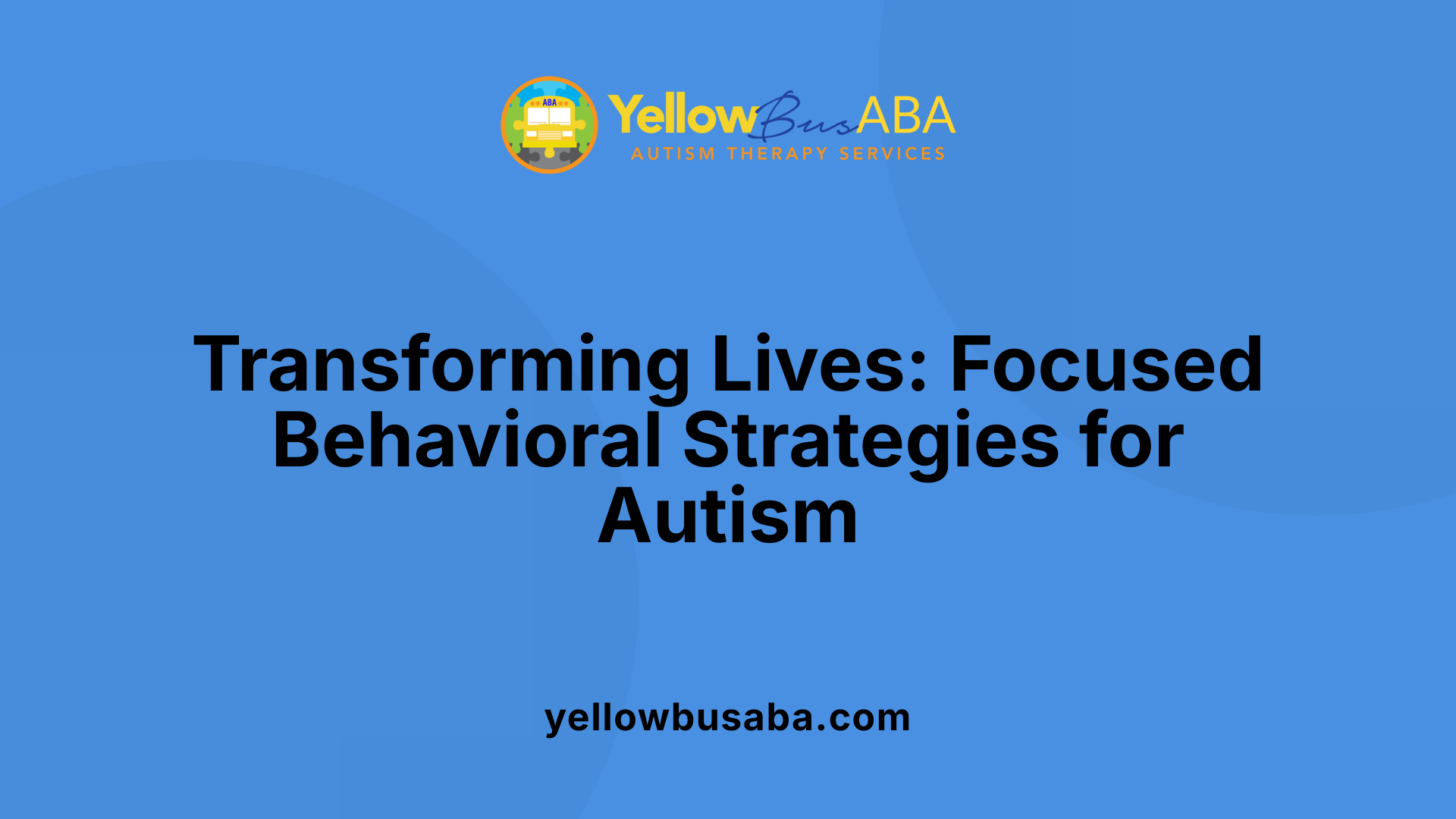How Therapists Use Positive Behavior Support to Shape Change
November 20, 2025
Harnessing Positive Behavior Support in Autism Therapy: Science Meets Compassion

Understanding the Foundations of Positive Behavior Support in Therapy
In the realm of autism treatment, therapists increasingly turn to scientifically backed strategies that emphasize positive change through reinforcement and understanding. Positive Behavior Support (PBS), grounded in the principles of Applied Behavior Analysis (ABA), offers a compassionate and evidence-based framework designed to promote meaningful behavioral improvements in individuals with autism and related developmental conditions. This article explores how therapists utilize PBS to shape change, enhance skills, and foster independence through personalized and data-driven interventions.
The Core Focus of Therapy: Shaping Positive Change Through Behavioral Analysis

What is the main focus of therapy when addressing autism using behavioral analysis?
When addressing autism, the main therapeutic goal of behavioral analysis therapy is to increase helpful behaviors while reducing harmful or interfering ones. This focus is achieved by carefully understanding the individual’s behavior and how it interacts with their environment. Applied Behavior Analysis (ABA), the primary method used, applies scientific principles to analyze behaviors and to develop strategies that foster positive and adaptive skills.
Role of ABA in understanding and modifying behaviors
ABA therapists use detailed assessments to understand the antecedents (what happens before a behavior), the behavior itself, and its consequences. This Antecedent-Behavior-Consequence (ABC) approach is vital in identifying the causes and maintaining factors of behaviors. By modifying these elements, ABA therapy effectively shapes actions to improve functioning. The therapy centers on observation, data collection, and measurable outcomes, continually refining interventions based on progress.
Use of positive reinforcement to encourage desirable behaviors
A cornerstone strategy in ABA is positive reinforcement. This involves rewarding desired behaviors immediately and consistently to increase the likelihood these behaviors will reoccur. For example, a child may receive praise or a favorite toy when they use words or pictures to request help instead of engaging in tantrums. Positive reinforcement not only encourages skill acquisition but also makes learning an enjoyable and motivating experience.
Target skill development areas including communication, social interaction, and self-care
ABA therapy aims to build essential life skills tailored to the individual’s needs. Critical areas targeted include:
- Communication: Expressing needs and thoughts effectively.
- Social Interaction: Engaging appropriately with peers and adults.
- Self-Care: Managing daily activities independently.
- Play and Motor Skills: Improving physical coordination and recreation.
- Academic Abilities: Enhancing learning and cognitive skills.
These areas are addressed through customized programs that foster skill generalization across various settings such as home, school, and community.
Assessment and individualized treatment planning
The process begins with a comprehensive Functional Behavior Assessment (FBA) conducted by a Board Certified Behavior Analyst (BCBA). This assessment identifies behavioral patterns and underlying causes. Based on this data, the BCBA develops a personalized Behavior Intervention Plan (BIP) with specific, measurable goals tailored to the individual's strengths, challenges, and family preferences.
Therapy progress is continuously monitored through data collection, allowing for the adjustment of goals and strategies to optimize outcomes. This individualized planning ensures that each person receives support that best suits their unique profile and promotes lasting positive change.
Who Provides Positive Behavior Support and How Is Therapy Delivered?

Roles of Board Certified Behavior Analysts (BCBAs), BCaBAs, and Registered Behavior Technicians (RBTs)
Therapy for autism using behavioral analysis is primarily provided by professionals with specialized training. Board Certified Behavior Analysts (BCBAs) serve as clinical leaders who design and oversee personalized treatment plans tailored to each individual's needs. They work alongside assistant behavior analysts (BCaBAs) and Registered Behavior Technicians (RBTs), who usually carry out hands-on therapy sessions under BCBA supervision.
Supervision and Credential Requirements for Providers
Quality ABA therapy depends on providers holding proper certifications and adhering to licensing standards. BCBAs complete rigorous education and credentialing processes to develop expertise in behavior analysis. RBTs, while delivering therapy directly, operate under continuous supervision by BCBAs to maintain treatment fidelity and ensure effective intervention grounded in research.
Settings Where Therapy Is Delivered
ABA and Positive Behavior Support (PBS) services are available across multiple environments including in-home settings, schools, and community centers. This flexibility helps generalize skills to real-life contexts, supporting meaningful improvements in communication, social, and self-care abilities.
Process for Starting Therapy: Assessments and Authorization
Starting ABA therapy involves a structured process beginning with a clinical assessment conducted by a behavior analyst, often a BCBA. This assessment evaluates individual strengths and challenges, guiding the creation of a personalized treatment plan. Authorization through insurance or Medicaid is often required before therapy can commence. Regular evaluations and progress monitoring ensure that goals remain relevant and effective.
Importance of Choosing Qualified and Experienced Providers
Selecting providers with verified credentials and experience is vital for achieving the best outcomes. Families may consult healthcare professionals, insurance resources, or reputable organizations such as the Behavior Analyst Certification Board (BACB) to locate qualified ABA practitioners. Experienced providers bring expertise in tailoring interventions, incorporating positive reinforcement techniques, and offering training to families to support consistent progress.
This multi-tiered provider structure and diverse service delivery enable highly individualized and effective ABA therapy for individuals with autism.
Key Principles and Techniques of Positive Behavior Support

Understanding antecedents, behaviors, and consequences using the ABC model
Applied Behavior Analysis (ABA) therapy, central to Positive Behavior Support (PBS), employs the Antecedent-Behavior-Consequence (ABC) model to analyze behaviors. This model examines what happens before a behavior (antecedent), the behavior itself, and what follows (consequence). By understanding these elements, therapists tailor interventions to effectively modify behaviors.
Positive reinforcement strategies and their importance
A cornerstone of PBS is positive reinforcement, which involves rewarding desirable behaviors to increase their frequency. Rather than using punishment, PBS emphasizes encouraging helpful behaviors through motivating rewards, leading to more sustainable and beneficial behavior changes.
Common ABA techniques used in PBS
PBS integrates several ABA methodologies to support skill development and behavior modification:
- Discrete Trial Training (DTT): A structured one-on-one teaching method focusing on breaking tasks into small steps with repeated practice and reinforcement.
- Pivotal Response Treatment (PRT): A less formal approach that emphasizes learning through play and the child’s natural environment, enhancing motivation and self-initiation.
- Early Start Denver Model (ESDM): Combines play-based learning with ABA techniques, targeting multiple developmental goals within engaging activities.
Emphasis on positive social interactions and enjoyable learning experiences
PBS promotes therapies that focus on positive social interactions. By creating enjoyable and engaging learning environments, individuals are more motivated to participate and develop essential social and communication skills, fostering greater independence.
Individualization and skill generalization across environments
Each PBS program is customized to meet the individual's unique needs, with an emphasis on generalizing learned skills across various settings such as home, school, and community. This ensures that improvements are practical and long-lasting in real-world scenarios.
Assessment, Data Collection, and Program Planning in PBS

What is the Initial Functional Behavior Assessment (FBA) in PBS?
The Functional Behavior Assessment (FBA) is the foundational step in Applied Behavior Analysis (ABA) therapy within the Positive Behavior Support (PBS) framework. It involves carefully analyzing the antecedents (what happens before a behavior), the behavior itself, and the consequences to understand the purpose that a behavior serves for an individual. This comprehensive evaluation allows behavior analysts to identify the root causes of challenging behaviors and informs the creation of effective strategies.
How are Behavior Intervention Plans (BIPs) tailored in PBS?
Following the FBA, a Behavior Intervention Plan (BIP) is developed. The BIP is highly individualized, crafted by Board Certified Behavior Analysts (BCBAs) to address the unique needs, skills, and circumstances of the person receiving therapy. It sets specific, measurable goals designed to increase helpful behaviors and reduce harmful ones, often targeting improvements in communication, social skills, self-care, and academic abilities.
Why is ongoing data collection crucial in PBS?
Progress in ABA therapy under PBS relies heavily on continuous data collection during sessions. Therapists collect detailed information on behavior patterns and skill acquisition, enabling regular evaluation of the intervention’s effectiveness. This data-driven approach allows for timely adjustments to treatment plans, ensuring that interventions stay aligned with the individual's evolving needs and maximize therapeutic outcomes.
What is the role of BCBAs in program planning and supervision?
BCBAs play a central role by leading the assessment process, designing customized treatment plans, and supervising Registered Behavior Technicians (RBTs) during therapy delivery. Their expertise guarantees the use of validated, research-supported strategies, adherence to ethical standards, and high-quality, consistent care tailored for each individual.
How does PBS incorporate evidence-based practices and research?
PBS strongly emphasizes evidence-based practices. The methodologies used are grounded in peer-reviewed scientific literature and supported by professional organizations such as the American Psychological Association. This research foundation ensures that interventions are effective, replicable, and continually refined based on emerging scientific findings, guaranteeing the best possible support for individuals with autism and related behavioral challenges.
PBS Impact and Accessibility: Evidence-Based Outcomes and Support

Recognition of ABA and PBS as Evidence-Based Best Practices
Applied Behavior Analysis (ABA) therapy and Positive Behavior Support (PBS) are widely recognized as evidence-based best practice treatments. Esteemed professional bodies such as the US Surgeon General and the American Psychological Association endorse ABA for its effectiveness in addressing autism and related behavioral challenges. PBS, grounded in ABA principles, emphasizes positive reinforcement and research-based strategies, further supporting its credibility as a proven method.
Positive Outcomes in Key Developmental Areas
PBS and ABA therapies contribute significantly to improving communication, social skills, motor abilities, and reducing problematic behaviors. These approaches help individuals build essential life skills while increasing appropriate behaviors. By using individualized treatment plans and ongoing data monitoring, they ensure steady gains and meaningful progress for clients across all ages.
Insurance Coverage and Service Accessibility
Access to ABA and PBS services often depends on insurance coverage, which varies by provider and geography. Many private insurance plans and Medicaid provide coverage when the therapy is deemed medically necessary. Families looking to start therapy can consult healthcare professionals or resources like the Autism Speaks Resource Guide to identify qualified providers and understand coverage options.
Therapist Training and Family Involvement
Organizations like PBS offer comprehensive training courses for therapists, such as the 40 Hour Registered Behavior Technician (RBT) Course, ensuring high standards of care. Families are also actively involved in the therapeutic process, empowering them to reinforce skills learned during sessions in home and community settings.
Broad Support Across Ages and Environments
PBS programs support individuals throughout their lifespan and across diverse settings—including in-home, schools, and community environments. This comprehensive support framework enables continuity of care and encourages skill generalization, helping individuals thrive in multiple social contexts.
Shaping Meaningful Change Through Compassionate Behavior Support
Positive Behavior Support represents a transformative approach in autism therapy by combining rigorous scientific analysis with empathetic, individualized care. Through the expertise of credentialed professionals and the strategic use of Applied Behavior Analysis techniques, PBS offers hope and measurable progress to individuals with behavioral challenges and developmental disabilities. Its emphasis on positive reinforcement, ongoing evaluation, and the collaboration of families and therapists ensures that meaningful, lasting improvements are attainable. As awareness and accessibility of PBS grow, so too does the promise of enhancing quality of life for countless individuals and their communities.
References
- Applied Behavior Analysis (ABA)
- ABA Therapy | Applied Behavior Analysis | PBS Corporation
- ABA Therapy Examples, Definition & Techniques
- ABA Therapy for Autism | Benefits, Techniques & How It ...
- Applied Behavior Analysis (ABA)
- Who Qualifies for ABA Therapy: Eligibility Guide
- Applied Behavior Analysis (ABA)
- Qualifications of Behavior Service Providers
- Understanding Your Child's ABA Therapy Providers
- Applied Behavior Analysis (ABA)


.avif)



